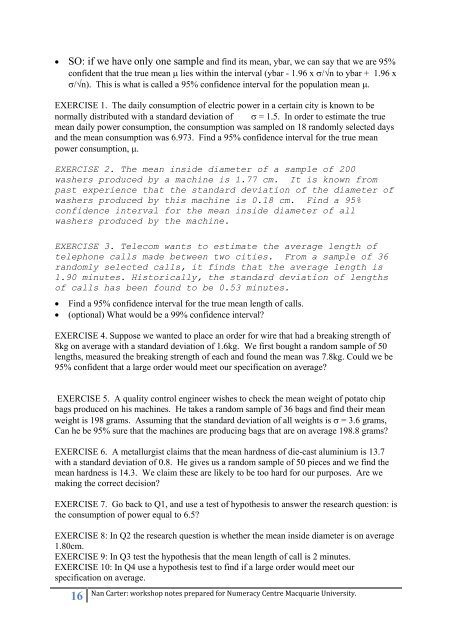STAT170 Workshop Notes prepared by Nan Carter for Numeracy ...
STAT170 Workshop Notes prepared by Nan Carter for Numeracy ...
STAT170 Workshop Notes prepared by Nan Carter for Numeracy ...
Create successful ePaper yourself
Turn your PDF publications into a flip-book with our unique Google optimized e-Paper software.
• SO: if we have only one sample and find its mean, ybar, we can say that we are 95%<br />
confident that the true mean μ lies within the interval (ybar - 1.96 x σ/√n to ybar + 1.96 x<br />
σ/√n). This is what is called a 95% confidence interval <strong>for</strong> the population mean μ.<br />
EXERCISE 1. The daily consumption of electric power in a certain city is known to be<br />
normally distributed with a standard deviation of σ = 1.5. In order to estimate the true<br />
mean daily power consumption, the consumption was sampled on 18 randomly selected days<br />
and the mean consumption was 6.973. Find a 95% confidence interval <strong>for</strong> the true mean<br />
power consumption, μ.<br />
EXERCISE 2. The mean inside diameter of a sample of 200<br />
washers produced <strong>by</strong> a machine is 1.77 cm. It is known from<br />
past experience that the standard deviation of the diameter of<br />
washers produced <strong>by</strong> this machine is 0.18 cm. Find a 95%<br />
confidence interval <strong>for</strong> the mean inside diameter of all<br />
washers produced <strong>by</strong> the machine.<br />
EXERCISE 3. Telecom wants to estimate the average length of<br />
telephone calls made between two cities. From a sample of 36<br />
randomly selected calls, it finds that the average length is<br />
1.90 minutes. Historically, the standard deviation of lengths<br />
of calls has been found to be 0.53 minutes.<br />
• Find a 95% confidence interval <strong>for</strong> the true mean length of calls.<br />
• (optional) What would be a 99% confidence interval?<br />
EXERCISE 4. Suppose we wanted to place an order <strong>for</strong> wire that had a breaking strength of<br />
8kg on average with a standard deviation of 1.6kg. We first bought a random sample of 50<br />
lengths, measured the breaking strength of each and found the mean was 7.8kg. Could we be<br />
95% confident that a large order would meet our specification on average?<br />
EXERCISE 5. A quality control engineer wishes to check the mean weight of potato chip<br />
bags produced on his machines. He takes a random sample of 36 bags and find their mean<br />
weight is 198 grams. Assuming that the standard deviation of all weights is σ = 3.6 grams,<br />
Can he be 95% sure that the machines are producing bags that are on average 198.8 grams?<br />
EXERCISE 6. A metallurgist claims that the mean hardness of die-cast aluminium is 13.7<br />
with a standard deviation of 0.8. He gives us a random sample of 50 pieces and we find the<br />
mean hardness is 14.3. We claim these are likely to be too hard <strong>for</strong> our purposes. Are we<br />
making the correct decision?<br />
EXERCISE 7. Go back to Q1, and use a test of hypothesis to answer the research question: is<br />
the consumption of power equal to 6.5?<br />
EXERCISE 8: In Q2 the research question is whether the mean inside diameter is on average<br />
1.80cm.<br />
EXERCISE 9: In Q3 test the hypothesis that the mean length of call is 2 minutes.<br />
EXERCISE 10: In Q4 use a hypothesis test to find if a large order would meet our<br />
specification on average.<br />
16<br />
<strong>Nan</strong> <strong>Carter</strong>: workshop notes <strong>prepared</strong> <strong>for</strong> <strong>Numeracy</strong> Centre Macquarie University.
















